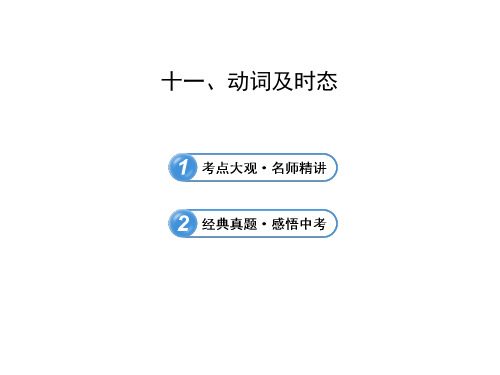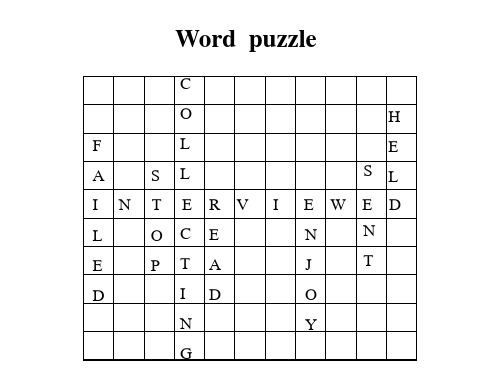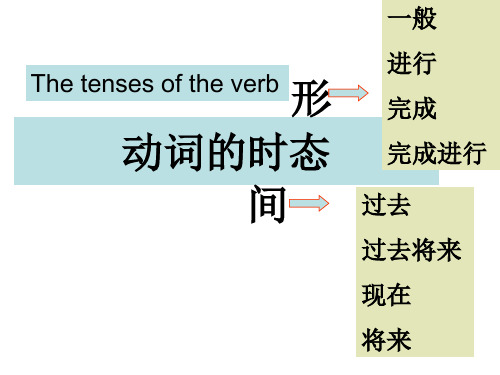初中英语语法动词时态 ppt课件
合集下载
英语时态8种基本时态讲解.ppt课件

4)动词过去式变化规则。 a)一般情况下的词加-ed. work---worked call----called b)以不发音的字母e结尾的单词直接加-d . live----lived change----changed smoke----smoked die----died graduate----graduated drive----drove
8.过去完成时 表示动作发生在过去某一时间之前已经完成的动作或状态, 强调“过去的过去”, 常与 by the time, by the end of…,before , by 等引导时间的状语连用。
基本结构 主语+ had + 动词过去分词 + 其他成分 When I got to the cinema yesterday the film had begun already. He had learned English before he came here.
现在完成时与一般过去时的区别: 1)现在完成时侧重于对现在的影响;而一般过去时侧重于某一动作发生在过去某个时间或某段时间。即现在完成时侧重于现在的结果,而一般过去时侧重于动作发生的时间。例如:
I have seen the film. 我看过这部电影。(现在我仍记得电影的内容) I saw the film three days ago. 三天前我看了这部电影。(强调是三天前,而不是别的什么时候看的电影)
be going to含有“打算,准备”的意思,而will则没有这个意思, She is going to lend us her book. He will be here in half an hour.
be about to+V.原形(意为马上做某事,在时间上指最近的将来) I am about to leave school. 不能与表示时间的副词连用。 They are about to set out.(√) They are about to set,变y为i加-ed. study----studied carry----carried cry----cried try----tried d)以元音字母+y结尾的单词直接加-ed. play----played stay----stayed
8.过去完成时 表示动作发生在过去某一时间之前已经完成的动作或状态, 强调“过去的过去”, 常与 by the time, by the end of…,before , by 等引导时间的状语连用。
基本结构 主语+ had + 动词过去分词 + 其他成分 When I got to the cinema yesterday the film had begun already. He had learned English before he came here.
现在完成时与一般过去时的区别: 1)现在完成时侧重于对现在的影响;而一般过去时侧重于某一动作发生在过去某个时间或某段时间。即现在完成时侧重于现在的结果,而一般过去时侧重于动作发生的时间。例如:
I have seen the film. 我看过这部电影。(现在我仍记得电影的内容) I saw the film three days ago. 三天前我看了这部电影。(强调是三天前,而不是别的什么时候看的电影)
be going to含有“打算,准备”的意思,而will则没有这个意思, She is going to lend us her book. He will be here in half an hour.
be about to+V.原形(意为马上做某事,在时间上指最近的将来) I am about to leave school. 不能与表示时间的副词连用。 They are about to set out.(√) They are about to set,变y为i加-ed. study----studied carry----carried cry----cried try----tried d)以元音字母+y结尾的单词直接加-ed. play----played stay----stayed
初中英语语法动词及时态ppt课件

过去进行时 主语+was/were+v. -ing+其他
现在完成时 主语+have/has+过去分词+其他
中学阶段见到的其他时态 时态
构成
过去完成时 主语+had+过去分词+其他
过去将来时
现在完成 进行时
主语+would+动词原形+其他 主语+was/were going to+动词原形
主语+have/has+been+现在分词+其他
状语
【温馨提示】
(1)在含有时间状语从句的复合句中,延续时间较长的动作用过 去进行时,另一个短暂性动作用一般过去时。例如:
My pen dropped on the ground when I was walking in the park. 在公园散步的时候,我的钢笔掉到地上了。
(2)表示两个延续性动作在过去某一时刻同时进行,不考虑动作 的先后顺序,主句和从句的谓语动词都用过去进行时,连词常 用while。例如:
词
宾语,又分为及物动词和 不及物动词。
物动 run , walk , cry , 词 swim,fall,happen
连
系 连接主语和表示主语身份、be , seem , look , become ,
动
性质、状态的动词称为连 get , grow , feel , appear ,
系动词。
turn
day等频率副词或时间状语 month.
连用
我们每月都去看望刘叔叔。
用法
例句
表示客观事实或普遍真理 The sun rises in the east. 太阳在东方升起。
初中英语语法动词时态ppt精品课件

3.e.g. Do you see a plane in the sky?
4. 注意:1) feel 可以用一般时和进行时表示说话
时的感觉:
5. e.g. I am not feeling well today.
6.
How are you feeling today?
7.
I feel tired.
8.
e.g. He was writing a composition last night.(作文不一定完成) He wrote a composition last night.(作文肯定 写完了)
(5) 现在完成时 I. 构成: have / has + 动词的过去分词 II. 用法:
1. 表示说话前某一个时刻发生的动作之结果对现 在的影响。
e.g. I hope you will enjoy your meal.
I want to visit them tomorrow.
4. 当有些感觉动词词义转变,成为表示动作的动词 时,可以用进行时: e.g. Now I see the liquid in the glass has turned red.
e.g. He was doing shopping this time yesterday. We were having a discussion at that time. 2. 表示过去某一阶段正在进行的动作. 1. e.g. Peter was playing chess the whole
4. 用与时间或条件状语从句中, 代替一般将来时: e.g. I will be happy if you all come. We will go when he comes.
初中英语八种时态归纳PPT

10. About 400 years ago, Galileo proved that the earth travels (travel) around the sun.
Part B 语态
Active Voice
Passive Voice
主动语态
1. Many people speak English.
At the party.
--- I _l_ik_e___ your jacket, Tim. How long _h_a_v_e_y_o_u__h_a_d__ it?
Oh…er… I __b_o_u_g_h_t__it last week. W__o_u_l_d_y_o_u__li_k_e_ to dance, Becky? ---Phew. It’s __h_o_t__ here. --- Put your jacket on the chair. You ____n_e_e_d_n’wt orry. It’ll be ok. ---That’s _b_e_tt_e_r __.
8. Mr. Green and his wife had lived (live) in London for a few years before they came (come) to work in China in 2001.
9. He said he w__o_u_ld__n_o_t_s_p_e_a(k not,speak) at the meeting the next day.
4. Hurry! Your classmates _a_r_e_w__a_it_i_n_g(wait) for you in the classroom..
1. This is the third time you _h_a_v_e__b_e_e_n__(be) here.
Part B 语态
Active Voice
Passive Voice
主动语态
1. Many people speak English.
At the party.
--- I _l_ik_e___ your jacket, Tim. How long _h_a_v_e_y_o_u__h_a_d__ it?
Oh…er… I __b_o_u_g_h_t__it last week. W__o_u_l_d_y_o_u__li_k_e_ to dance, Becky? ---Phew. It’s __h_o_t__ here. --- Put your jacket on the chair. You ____n_e_e_d_n’wt orry. It’ll be ok. ---That’s _b_e_tt_e_r __.
8. Mr. Green and his wife had lived (live) in London for a few years before they came (come) to work in China in 2001.
9. He said he w__o_u_ld__n_o_t_s_p_e_a(k not,speak) at the meeting the next day.
4. Hurry! Your classmates _a_r_e_w__a_it_i_n_g(wait) for you in the classroom..
1. This is the third time you _h_a_v_e__b_e_e_n__(be) here.
初中英语中考复习时态讲解课件(共79张ppt)

一般现在时
1. 表示经常性或习惯性的动作
She does excersice everyday.
真题链接
—What do you often do at weekends?
—I often ____ my grandparents.
A. visit
B. visited
C. have visited D. will visit
Just a moment, I am washing dishes.
when
习题
Just a minute! My brother________ his car in the garden. A. washes B. is washing C. washed D. will wash
习题
---Hey, Tom. Let’s go swimming.
动词过去分词 不规则变化
speak hear see give build swim buy teach
spoken heard seen given built swum bought taught
现在完成时
already yet
1.过去发生或已完成的某一动作对现在的影响。
I have already watched this film. I haven't watched this film yet. I have already visited America. I haven't visited America yet.
A. prepares
B. is preparing
C. has prepared D. prepared
真题链接
--Mum, it's late. Why are you still here? --Dad hasn't come back yet. I ____ for him. A. am waitingB. was waiting C. waited D. had waited
2024年中考英语复习第十章:动词的时态和语态课件

在看电视。 2. 过去进行时常与always等表示频率的副词连用,表示过去频繁发生的习惯性动作。此 时的过去进行时有一点的感情色彩。 • Alice was always changing her mind. 爱丽丝总是改变主意。 时间状语:this morning, the whole morning, all day ,yesterday, from nine to ten
5. 对现在进行时的特殊疑问句的回答,它不可以用Yes或No直接作答,要根据实际
情况回答。
• -Yes,he is.是的。
-No,he isn't.不是。
现在进行时
现在分词的变化 1. 动词的后面直接加-ing。 • work-working,study-studying, play-playing 2. 以不发音的字母e结尾的动词,先去掉字母e,再加-ing。 • live-living 3. 以重读闭音节结尾并且只有一个辅音字母的动词,先双写这个辅音字母,再加- ing。 • stop-stopping,swim-swimming,run-running, get-getting
现在进行时
现在进行时的句式变化:
1. 肯定句式:主语+be( am, is, are)+现在分词+其它.
• Li Hua is cleaning the classroom.李华在打扫教室
2. 否定句式:主语+be(am, is, are) +not +现在分词+其它.
• Li Hua isn't cleaning the classroom.李华不是在打扫教室,
04
过去进行时
过去进行时
用法
5. 对现在进行时的特殊疑问句的回答,它不可以用Yes或No直接作答,要根据实际
情况回答。
• -Yes,he is.是的。
-No,he isn't.不是。
现在进行时
现在分词的变化 1. 动词的后面直接加-ing。 • work-working,study-studying, play-playing 2. 以不发音的字母e结尾的动词,先去掉字母e,再加-ing。 • live-living 3. 以重读闭音节结尾并且只有一个辅音字母的动词,先双写这个辅音字母,再加- ing。 • stop-stopping,swim-swimming,run-running, get-getting
现在进行时
现在进行时的句式变化:
1. 肯定句式:主语+be( am, is, are)+现在分词+其它.
• Li Hua is cleaning the classroom.李华在打扫教室
2. 否定句式:主语+be(am, is, are) +not +现在分词+其它.
• Li Hua isn't cleaning the classroom.李华不是在打扫教室,
04
过去进行时
过去进行时
用法
初中英语动词的时态和被动语态(共14张PPT)

延续性动词 be on be at/in+地点 be at/in+地点 be in/a member of be on have know keep
have a cold
have been to—have gone to
曾经去过(主语人在) 已经去了(主语人不在)
--I can’t find you these days.Where have you been?
be over be up be back be away (from) be here /there
非延续性动词 put on come/go to arrive/reach/get to join begin/start buy get to know borrow / lend
catch a cold
定义 表示过去某时间或某动作以前发生的动作。
结构 关健字
S+had+V过去分词
IwSr+heheaanlidzIner’det+aIVchh过ae去dd分let词hftemcoyupHnutar.sde+Sa+t Vh过om去分e词
by the time I came back,by the end of last term, when I got to the station,before he went to bed
表示过去某时刻或某阶段正在发生的动作。
was
1.SW+hawtawsna’st /hwe edroein’gt dwohinegn the UFO arrived?
结构 S+ weredoing 2W. Tahse/yWweerree+hSav+idnoginfugn…th?ese days.
初中英语语法—时态(28张) PPT课件 图文

(4)现在完成时与表示一段时间的for短语、since短语或从句等 时,应注意句中的谓语动词须是延续性的,而不能是非延续性动词,如 come→be here,go→be there,die→be dead,borrow→keep,buy→h ,join→be in,leave→be away,begin to study→study等。
6.过去进行时
(1)概念:表示过去某一时刻或某一时间段内正在进行的动作。 (2)构成形式:was/were+动词的-ing形式 ①表示往返、位移的动词的过去进行时常可用来表示过去将来时
时态 We wanted to tell her that the train was_leaving an hour later.
1.一般现在时
基本用法: (1)表示经常性、习惯性的动作; He always helps others. 他总是帮助别人。
时态 (2)表示现在的情况或状态;
He is a teacher. 他是个老师。 (3)表示客观事实和普遍真理。 The sun rises in the east. 太阳从东边升起。 构成形式:am/is/are或实义动词的原形(主语是第三人称单数时,动 词要用第三人称单数形式)。
时态 (2)构成形式:have/has+动词的过去分词。
(3)与现在完成时连用的时间状语有for a long time,recently,yet, lately,ever,never,already,since,by this time,before,just,in t past/last few years,since+过去的时间点,since+时间段+ago,since +从句(一般过去时)。
表示感觉的动词。如:see,hear等。 表示喜欢或厌恶的动词。如:like,love等。 表示希望的动词。如:want,would like等。
- 1、下载文档前请自行甄别文档内容的完整性,平台不提供额外的编辑、内容补充、找答案等附加服务。
- 2、"仅部分预览"的文档,不可在线预览部分如存在完整性等问题,可反馈申请退款(可完整预览的文档不适用该条件!)。
- 3、如文档侵犯您的权益,请联系客服反馈,我们会尽快为您处理(人工客服工作时间:9:00-18:30)。
He is seeing his friend off at the airport.
I think they will come. We are all thinking hard.
The report shows the problem is serious. He is showing them around our school.
3.e.g. Do you see a plane in the sky?
4. 注意:1) feel 可以用一般时和进行时表示说话
时的感觉:
5. e.g. I am not feeling well today.
6.
How are you feeling today?
7.
I feel tired.
8.
5. -- __I_s_ my son __w_o_r_k_in_g___ (work) hard this term?
6. -- Oh, yes, he _is__tr_y_i_n_g__(try) his best now.
7. 6. D__o_e_s__ the hatfi_t______ (fit) me well?
e.g. I hope you will enjoy your meal.
I want to visit them tomorrow.
4. 当有些感觉动词词义转变,成为表示动作的动词 时,可以用进行时: e.g. Now I see the liquid in the glass has turned red.
3.
常搭配的时间状语:
4. always often usually sometimes
5. seldom never from time to time
6. now and then (偶尔) every day
every ….
7. once a week
8.2.表示状态:
9. e.g. He is busy at the moment.
Exercise:
1. Water f_r_e_e_ze_s_(freeze) at the temperature 0.
2. The air _k_e_e_p_s( keep ) moving all the time.
3. The town _l_ie_s__( lie) to the west of the hill. 4. I _b_e_l_ie_v_e_( believe) you _a_re__te_l_li_n_gtell the truth now.
动词时态
初中阶段8种时态: 1.一般现在时 2.一般过去时 3.一般将来时 4.现在进行时 5.过去进行时 6.现在完成时 7.过去完成时 8.过去将来时
(1) 一般现在时:
1.表示经常反复发生的动作.
2. e.g. They often spend their holidays in
the south.
2) see, hear 有相应表示动作的动词 look
at / listen to , 这些词可以用进行时
比较: Do you see a map on the wall?
He is looking at a map on the wall.
I hear a strange noise from the car engine.
进行)的动作: 4. e.g. We are writing a paper these days.
一般现在时与现在进行时的区别
1.进行时强调动作正在进行,而现在时强调动作的
经常和反复,或特征,这类动作没有时间性的.
2.某些表示感官知觉的动词如: see, hear, smell,
taste等表示感觉,用一般时,不用进行时.
it up. lived
10.8. Sam ____( live) in the small town fhoarvfievegryoewanrs
during the war.
saw
11.9. It is ages since I last ____(see) you. You
___(grow) taller.
10.3. 表示客观真理,谚语,格言.
11. e.g. The sun sets in the west.
4. 用与时间或条件状语从句中, 代替一般将来时: e.g. I will be happy if you all come. We will go when he comes.
(2) 现在进行时 1.表示说话时正在进行的动作. 2. e.g. He is walking towards the plane. 3.2. 表示目前一阶段正在进行(但说话时不一定在
He is listening to the music. 3. 有些表示状态或心理感觉的动词一般不用现在
进行时,而用一般现在时表示状态或感觉,如 love, like, hate, want, need, wish, know(知道), understand(懂得), remember(记得), believe, guess(认为), mean(意味着), think(认为), feel(认为), fit(合适), find(认为), show(表明), have(有)
gቤተ መጻሕፍቲ ባይዱt
(3) 一般过去时
1.表示过去某一具体时间发生过的动作.
2. e.g. I reviewed my lessons last night.
3.
注意: 1)有时句中虽然没有表示确定过
去时间的状语, 但根据上下文情景可以推断出是
过去发生过的动作,此时也应用一般过去时
4. e.g. I was sorry to learn of your illness.
8. 7. – What has happened to the fish, Mary?
9. -- Mum, the chaat s__e_a_te_n_ (eat) the fish. Just now
the jcuamt _p_e_d__(jump) onto the table anadte_____(eat)
I think they will come. We are all thinking hard.
The report shows the problem is serious. He is showing them around our school.
3.e.g. Do you see a plane in the sky?
4. 注意:1) feel 可以用一般时和进行时表示说话
时的感觉:
5. e.g. I am not feeling well today.
6.
How are you feeling today?
7.
I feel tired.
8.
5. -- __I_s_ my son __w_o_r_k_in_g___ (work) hard this term?
6. -- Oh, yes, he _is__tr_y_i_n_g__(try) his best now.
7. 6. D__o_e_s__ the hatfi_t______ (fit) me well?
e.g. I hope you will enjoy your meal.
I want to visit them tomorrow.
4. 当有些感觉动词词义转变,成为表示动作的动词 时,可以用进行时: e.g. Now I see the liquid in the glass has turned red.
3.
常搭配的时间状语:
4. always often usually sometimes
5. seldom never from time to time
6. now and then (偶尔) every day
every ….
7. once a week
8.2.表示状态:
9. e.g. He is busy at the moment.
Exercise:
1. Water f_r_e_e_ze_s_(freeze) at the temperature 0.
2. The air _k_e_e_p_s( keep ) moving all the time.
3. The town _l_ie_s__( lie) to the west of the hill. 4. I _b_e_l_ie_v_e_( believe) you _a_re__te_l_li_n_gtell the truth now.
动词时态
初中阶段8种时态: 1.一般现在时 2.一般过去时 3.一般将来时 4.现在进行时 5.过去进行时 6.现在完成时 7.过去完成时 8.过去将来时
(1) 一般现在时:
1.表示经常反复发生的动作.
2. e.g. They often spend their holidays in
the south.
2) see, hear 有相应表示动作的动词 look
at / listen to , 这些词可以用进行时
比较: Do you see a map on the wall?
He is looking at a map on the wall.
I hear a strange noise from the car engine.
进行)的动作: 4. e.g. We are writing a paper these days.
一般现在时与现在进行时的区别
1.进行时强调动作正在进行,而现在时强调动作的
经常和反复,或特征,这类动作没有时间性的.
2.某些表示感官知觉的动词如: see, hear, smell,
taste等表示感觉,用一般时,不用进行时.
it up. lived
10.8. Sam ____( live) in the small town fhoarvfievegryoewanrs
during the war.
saw
11.9. It is ages since I last ____(see) you. You
___(grow) taller.
10.3. 表示客观真理,谚语,格言.
11. e.g. The sun sets in the west.
4. 用与时间或条件状语从句中, 代替一般将来时: e.g. I will be happy if you all come. We will go when he comes.
(2) 现在进行时 1.表示说话时正在进行的动作. 2. e.g. He is walking towards the plane. 3.2. 表示目前一阶段正在进行(但说话时不一定在
He is listening to the music. 3. 有些表示状态或心理感觉的动词一般不用现在
进行时,而用一般现在时表示状态或感觉,如 love, like, hate, want, need, wish, know(知道), understand(懂得), remember(记得), believe, guess(认为), mean(意味着), think(认为), feel(认为), fit(合适), find(认为), show(表明), have(有)
gቤተ መጻሕፍቲ ባይዱt
(3) 一般过去时
1.表示过去某一具体时间发生过的动作.
2. e.g. I reviewed my lessons last night.
3.
注意: 1)有时句中虽然没有表示确定过
去时间的状语, 但根据上下文情景可以推断出是
过去发生过的动作,此时也应用一般过去时
4. e.g. I was sorry to learn of your illness.
8. 7. – What has happened to the fish, Mary?
9. -- Mum, the chaat s__e_a_te_n_ (eat) the fish. Just now
the jcuamt _p_e_d__(jump) onto the table anadte_____(eat)
